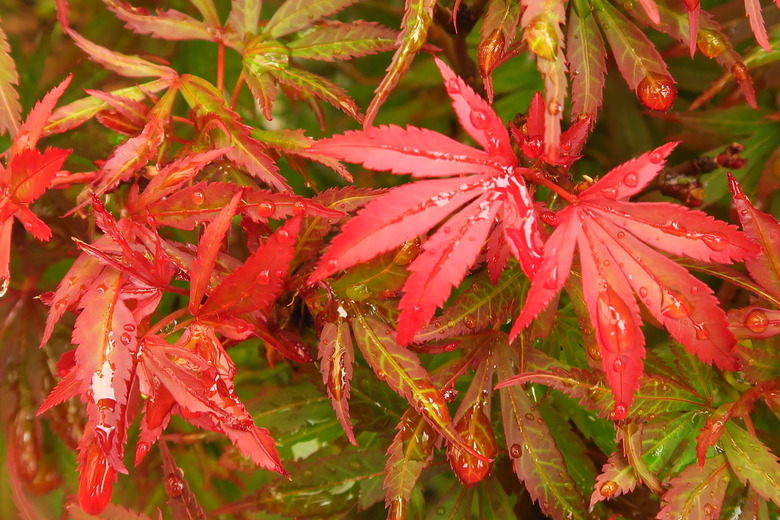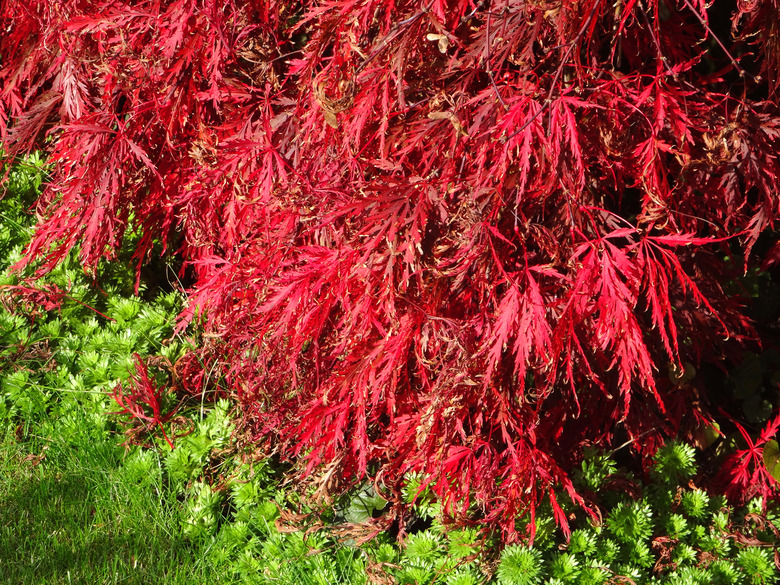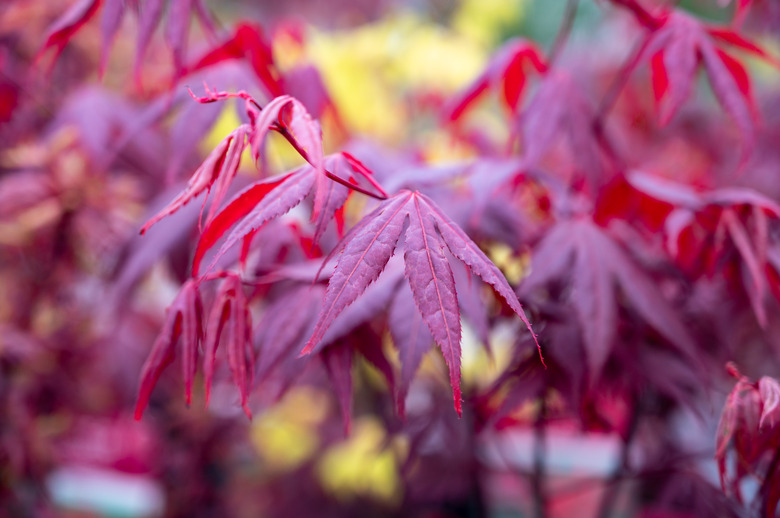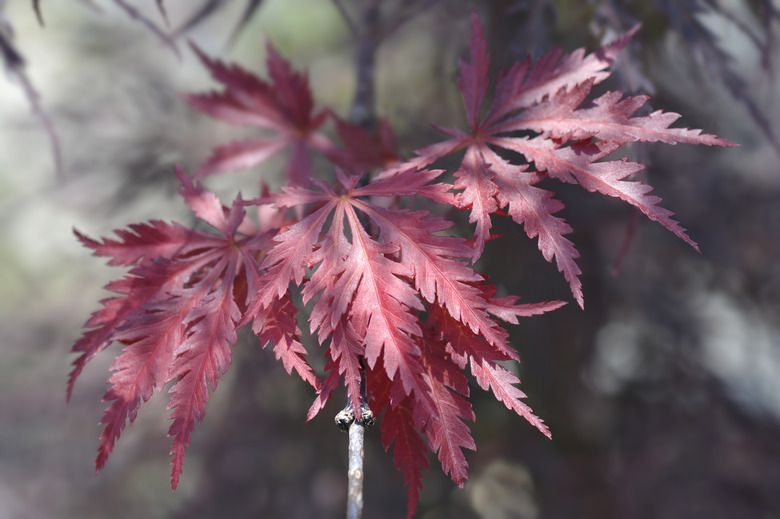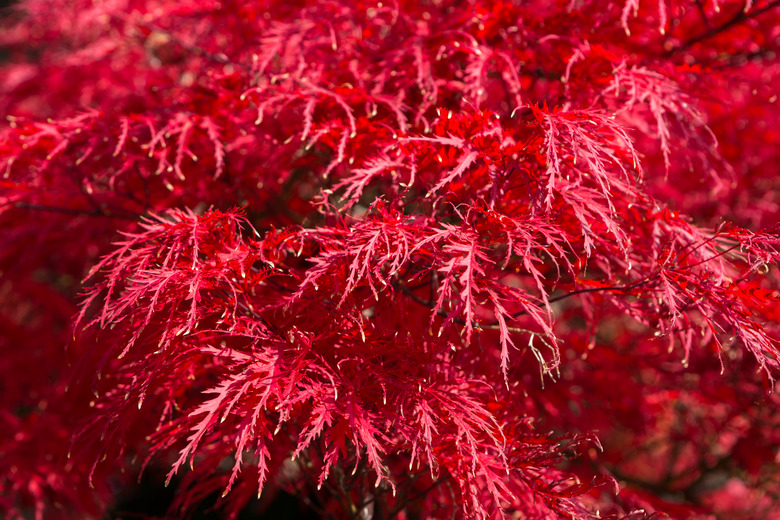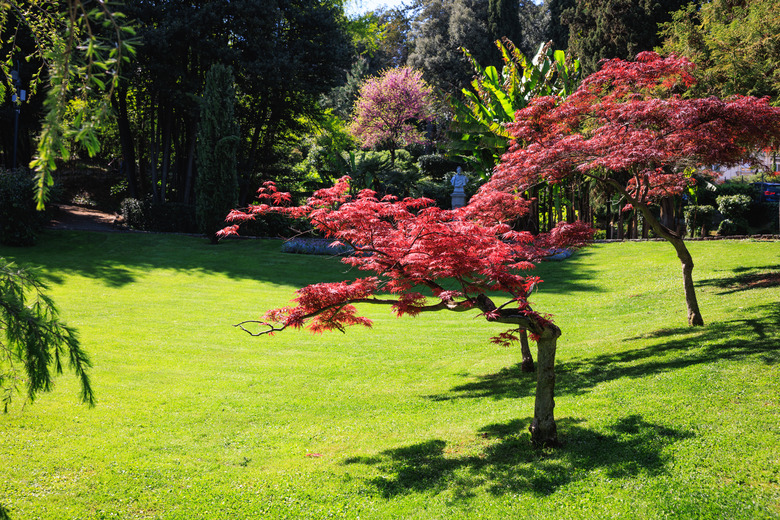Dwarf Red Japanese Maple Trees That Grow In Full Sun
Choices are limited when it comes to finding a red-leafed dwarf Japanese maple (Acer palmatum) for a sunny area of your garden, because few cultivars tolerate strong sunlight. Japanese maple trees grow best within U.S. Department of Agriculture plant hardiness zones 5a to 8b, where they are typically grown as accent trees for their showy foliage and graceful growth habit.
Few dwarf Japanese maples can tolerate full sun all day long, because their foliage is delicate and prone to burning. However, there are a couple of cultivars that need direct sun for at least part of the day to enhance the bright red color of their showy foliage.
About Dwarf Japanese Maples
Dwarf Japanese maples are slow-growing trees suited to small spaces. They all produce attractive foliage in shades of bright yellow, brilliant red, orange-red and golden yellow, as well as varieties with light green or variegated foliage.
The foliage often retains its color throughout the growing season but some varieties have bright green leaves in summer with fall color. As with all maples, the colorful red leaves are hand-shaped and some have lacy or serrated edges.
True dwarf Japanese maple tree varieties are rare, but some common cultivars only reach a mature height of 6 to 10 feet—so they will fit into a small garden or tight space just as well as a dwarf variety. Some varieties also grow well in a large containers, although they may require some bonsai pruning to maintain their size as they mature.
Red-Leafed Dwarf Japanese Maple Cultivars
Let's look at some cultivars of Japanese maples that sport red foliage and can be grown as dwarf trees.
Shaina Japanese Maple
Only a couple of Japanese maple tree cultivars with red leaves will tolerate full sun. One such cultivar is Shaina (Acer palmatum 'Shaina'), which grows best in USDA plant hardiness zones 5 to 8.
It has hand-shaped leaves with very light serration on the edges. New growth starts out bright red in spring and transitions to a deep, purple-red in autumn.
Shaina Japanese maples reach a mature height of just 6 to 8 feet and will tolerate full sun in cooler climates, but they need filtered midday shade in hot areas to prevent leaf burn.
Ever Red Japanese Maple
Another dwarf Japanese maple cultivar that sports red foliage and tolerates full sun is Ever Red (Acer palmatum 'Ever Red'), which grows best in USDA zones 5 to 8.
Ever Red is a weeping Japanese maple that will reach a height of 10 feet with a 10-foot spread. The foliage is maroon or garnet red during the summer months and darkens slightly before dropping in autumn. It needs moderate sun exposure to maintain its red foliage color, but morning and afternoon sun is best.
Tamukeyama Japanese Maple
Tamukeyama Japanese maple (Acer palmatum var. dissectum 'Tamukeyama') is a laceleaf maple cultivar that reaches just 6 to 10 feet in height, which puts it in the dwarf category. It grows best in USDA zones 5 to 8, where its feathery red foliage and graceful growth habit add beauty to gardens and landscaping beds.
Tamukeyama Japanese maple trees need sunlight to enhance their foliage color, but too much sun can scald their leaves—so it is best to provide partial shade in hot climates. Direct sun in the morning is best but late afternoon sun is also fine.
Growing Dwarf Japanese Maples
All dwarf Japanese maple varieties are steady, slow growers that need the right conditions to reach their full potential.
Growing Conditions
**Light:** Japanese maple trees need bright light with some direct sun in order to produce and maintain the bright red foliage they are known for, but too much direct sun can damage the foliage. Choose a location with morning and afternoon sun or, in warmer climates, choose a growing location with partial shade. A north- or east-facing bed is best for these trees in all but the coolest climates.
**Soil:** Japanese maple trees grow best in slightly acidic, fast-draining soil with a lot of organic matter mixed in. In soil with poor moisture retention, a layer of mulch spread around the base of the tree will help keep the roots moist. Avoid poor, sandy soil as well as heavy, clay-based soil that drains slowly.
**Shelter:** Japanese maple trees need shelter from strong, drying winds. Choose a growing location with a structure, shrubberies or a tall fence nearby that will block out prevailing winds. Tall trees to the south will also provide some light, dappled shade, which offers shelter from intense midday sunshine.
Warning
Avoid growing Japanese maple trees against an unshaded south-facing wall because the heat and light from the sun reflecting off the wall will damage them.
Basic Care
Dwarf Japanese maple trees do not require much hands-on care on a day-to-day basis but they will suffer without any care.
- Provide at least 1 inch of water each week during the growing season with a little extra in hot, dry weather. Water only when the soil feels dry on the surface. A 3- to 5-inch layer of mulch around the tree will help keep the soil moist and the roots protected—just be sure the mulch doesn't rest against the base of the trunk.
- Fertilizer is seldom necessary in newly planted Japanese maple trees, but a light application of compost or slow-release fertilizer in spring before the foliage opens can help boost growth in established trees.
- Prune Japanese maples to remove dead growth and to open up the canopy. Do not try to shape a Japanese maple because you can irreparably ruin its natural growth habit.
Tip
Dwarf Japanese maple trees are not invasive, but their dropped seeds can occasionally produce unwanted seedlings that need to be pulled up.
